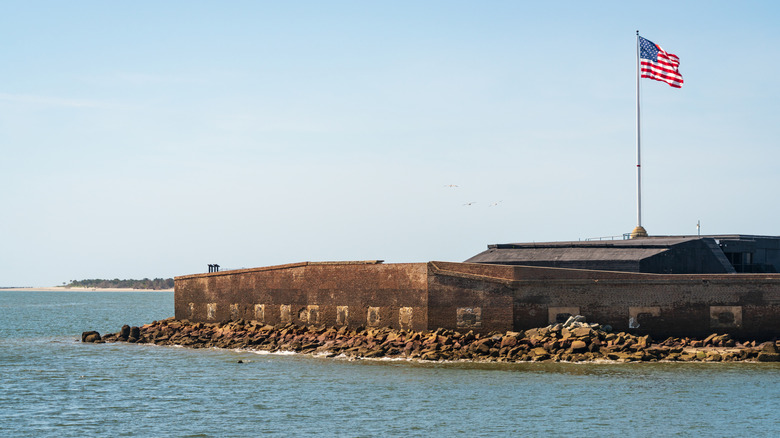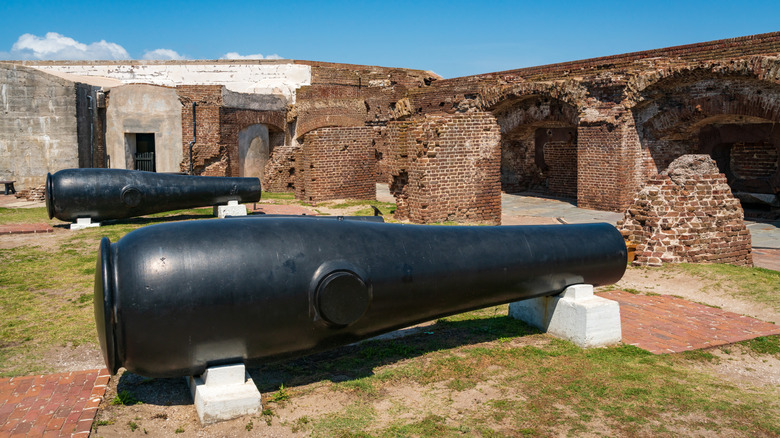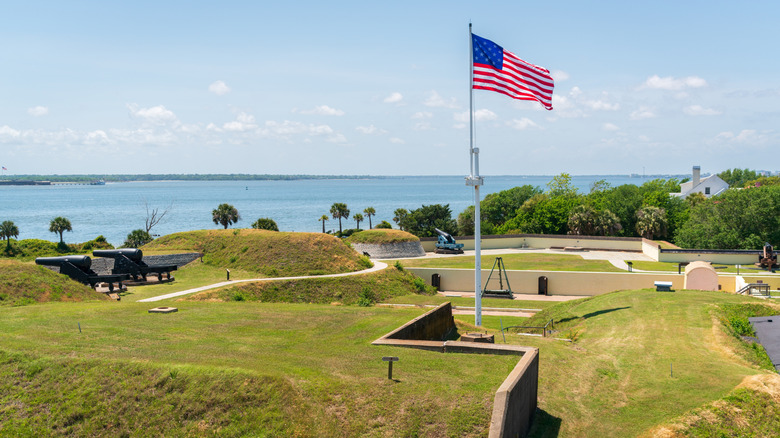Charleston's Sister Historic Sites Are Huge Relics Of Days Long Gone In One South Carolina Park
South Carolina's history is enmeshed in America's military past, with historic forts and battlefields preserved at important sites like Camden, South Carolina's oldest inland city full of Southern charm that once oversaw two Revolutionary War battles. The state's largest city, Charleston, had a particularly significant role during the American Revolutionary and Civil Wars, being the site of major harbor defenses. While Charleston's most romantic park may be Hampton Park, one of its most important, historically speaking, is Fort Sumter and Fort Moultrie National Historical Park. The forts' site, straddling two islands in the Charleston Harbor, is where the Civil War's first shots were fired.
The historical park played a role in the Revolutionary War as well. While Fort Sumter, sequestered on its own island, was pivotal during the Civil War, Fort Moultrie's history stretches further back, built as a means of defense during the American Revolution. It was where an important battle took place that resulted in the first iteration of South Carolina's flag being flown by the Continental Army. Aside from its layers of history, the park is also a beautiful place to simply get views over the Charleston skyline and harbor. The park is free to enter, though you'll need to buy a ferry ticket to visit the insular Fort Sumter.
See where the Civil War began at Fort Sumter
Though Fort Sumter is on its own little island, you'll start your visit in downtown Charleston at the Fort Sumter Visitor Center. It's about a 20-minute drive from the Charleston International Airport, and it's a pleasant, 30-minute walk from Charleston's romantic waterfront promenade at the Battery. The visitor center has exhibitions related to Charleston's harbor defenses and role in the Civil War, and it's only one of two points from which you can take a ferry to Fort Sumter (the other being Patriots Point Naval and Maritime Museum). The visitor center is free and open every day from 9:00 a.m. to 4:30 p.m.
Once the ferry docks at Fort Sumter, you'll step onto the remains of the man-made island fort, which was first constructed following the War of 1812 to build upon the Third System of Seacoast Defense. Around you, you'll see the original brick walls, partially ruined by time and battle. Walk through the archways of the fort to see gun batteries and some Civil War-era cannons. At the beginning of 1861, the fort was controlled by the Union, but Confederate forces decided to siege the fort as part of a strategy to take over Charleston's harbor. On April 12, 1861, the Confederates shot an explosive shell at Sumter, which would mark the start of the Civil War. The Confederates controlled the fort throughout the Civil War, but when they finally lost, its original Union leader, Major Robert Anderson, returned to raise the American flag over it.
Tour the Revolutionary War-era ruins of Fort Moultrie
Take the ferry back to the mainland, and then drive about 20 minutes to Fort Moultrie, which looks out to Fort Sumter but is located on a different island, Sullivan's Island. This fort was built in 1776, named after its general, William Moultrie. It was attacked by British warships before even being completed, but the palmetto logs that comprised the fort's walls were resilient and withstood hours of bombardment without intrusion. As Moultrie and his army returned fire, the general raised a blue flag bearing a crescent on it — the first version of South Carolina's official state flag. The fort later served Major Robert Anderson's army in the Civil War, before he moved his troops to Fort Sumter. It was also used during World War II as a defensive outpost against German U-boats.
There are a few fortifications and bunkers lining the shore of Sullivan's Island, with the main fortress building at Station 12. The Fort Moultrie Visitor Center near the remains has exhibits about the fort's history and plays a 22-minute informational film to prime you for a visit. Walk through the tunnels of the former batteries, explore the Revolutionary-era blockhouse ruins, and stop at General Moultrie's grave. Then, wind down at Sullivan's Island Beach, a must-visit beach that you can get to in five minutes by car or with a 30-minute walk from Fort Moultrie.


